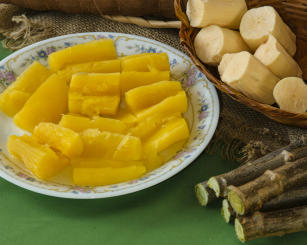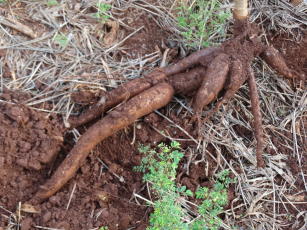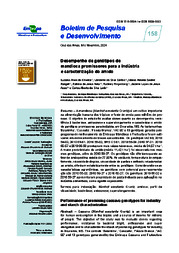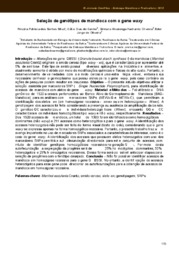Brazil in the race to develop waxy cassava starch
Brazil in the race to develop waxy cassava starch
A new variety of cassava can transform Brazil into a producer of a valuable industrial input and add extra value to the production of such native root. The waxy starch is sought by the food industry because it is a raw material for the composition of frozen foods and other products. The development of a waxy cassava variety, which is in progress at Embrapa, places the country at the forefront of the world race to develop waxy cassava that can be produced on a large scale. So far, no country has been able to develop this root.
The challenge is to have the plant itself generate such differentiated starch. An important advance was obtained by the International Center for Tropical Agriculture (Ciat), hosted in Colombia, which identified the cassava gene responsible for waxy starch. Embrapa was the only Brazilian institution that received this material and now intends to incorporate waxy starch production to a national variety. It thus hopes to combine the performance of the Brazilian material, which is already adapted to national conditions, with natural waxy starch production. The production costs will be the same of conventional cassava, hence waxy starch production should increase farmers' income.
By bringing to the composition of cassava characteristics that are especially important for the food industry, the novelty should reduce costs, once it reduces processing stages using the same production system of already known varieties. Waxy starch is different from native or common starch (also known as gum or fecula) and is considered the cassava product with higher added value because it is used in several types of industry.
“A differentiated starch does not mean that it is better that others. These are different products that have distinct applications. One is more viscous, the other freezes better, in other words, the one that is used in the paper industry is not used in the yoghurt industry”, exemplifies Francisco Laranjeira, deputy head of Research and Development at Embrapa Cassava and Fruits (Cruz das Almas, BA).
Less amylose is interesting for frozen foods
“The starch is composed basically by amylose and amylopectin [glucose molecules]. In most varieties, the amylose content varies from 17% to 25%, but in the industry there is a large interest in differentiated materials, especially at the ends of the chain,” explains the agrarian engineer Eder Jorge Oliveira, a researcher from Embrapa Cassava and Fruits, as he stresses that the waxy one offers little amylose. “Minimum amylose contents interest the food industry in view of lower starch retrogradation, which is the loss of water after the cooked product cools down”, clarifies Oliveira, who shares the work with the researchers Rudiney Ringenberg, Marcelo Romano and Saulo Oliveira.
“In our studies, we did not limit the breeding populations to the materials that had come from Ciat. We have tested other fronts because we need to generate new recombinants on top of finding new variants of the kind. The waxy gene has been sought at the Embrapa unit for ages, and the idea is that the program is continued, considering the positive advances in the discovery of waxy-associated mutations”, Eder asserts.
The world race for waxy cassava
“We are getting ahead of our time, since no one from the production chain has asked us for this product yet. Considering that Thailand [world's second largest cassava producer, losing only to Nigeria] is already developing its own waxy variety, Brazil cannot lag behind, at the risk becoming an importer of waxy cassava starch at some point”, ponders Laranjeira. “We are looking ahed to a future in partnership with the production chain. The intention is not to come up with the finished material, but to find ways to work in partnership from the beginning, as we know that technologies are more quickly adopted when the production chain participates in the technological development”.
The mission is significant as, besides good yield, the variety must have similar or higher disease resistance than traditional varieties, with adaptation to some regions of Central-South Brazil and the Northeast. “Besides the assessments for production attributes, we are interested in incorporating in the selection process traits related to the quality of the starch in terms of color, paste properties and amylopectin branching patterns that can result in the development of new products, especially for the food industry”, Eder states.
Closer ties with the sector in Brazil's Mid-South (Paraná, Mato Grosso do Sul, São Paulo and Santa Catarina), where the highest concentration of starch industries of the country is located, started in 2008, when Embrapa Cassava and Fruits set up an advanced research field with the support of Embrapa Soybeans (Londrina, PR), where three researchers of the Cassava Technical Team are stationed. As a result, two table varieties and an industry one have already been launched since 2015.
Eight industries in the region have revealed an initial interest in the waxy cassava project, which is at a negotiation stage. “It is a strategic project for the Unit, as it represents the development of a product of high added value and high level of innovation, which will become feasible through a partnership with the private sector”, asserts Aldo Vilar Trindade, deputy head of Technology Transfer, who has closely followed discussions.
A promising market for starch
According to a survey by the University of São Paulo's Center for Advanced Studies on Applied Economics (Cepea/USP), the national market for starch-mill processed cassava starch is expressive. “In 2016, Brazilian production was 616,230 tons”, informs Lucilio Alves, a Cepea member and professor of the “Luiz of Queiroz” College of Agriculture (Esalq/USP). From 2013 to 2016, four states in the Mid-South led national production. “Paraná was responsible for 68.1% of Brazilian production, Mato Grosso do Sul for 23.6%, São Paulo for 8%, and Santa Catarina for 0.3%”, Alves highlights.
The prospects for the use of waxy cassava starch are promising, once it has different properties than waxy maize, and it could reach new market niches and allow the creation of products with unique specificities. Waxy maize, for instance, is used by the food industry to produce frozen and chilled foods and to manufacture energy supplements aimed at athletes. “It is a good bet for industries, since waxy cassava production costs should the same of commercial varieties”, Oliveira underscores.
Better than maize
Its physical-chemical properties have stood out in comparison with waxy maize and rice starches, the main competitors. Its paste has proved to be 50% clearer and twice as resistant to freezing as waxy maize. It is also more soluble and absorbs more water as it presented insignificant water losses after refrigeration and freezing, which indicates potential to replace other starches in some industrial applications.
The use of the fecula tends to grow, once cassava byproducts have increasingly been consumed by people concerned about health and aesthetics. The root and its byproducts have also become a carbohydrate option for the coeliac patients - those who suffer from acute intolerance to gluten, an allergenic protein present in wheat, oats, rye, barley and malt.
The term "waxy" is well-known among gym goers, as waxy maize (or waxy maize starch) is prescribed by nutritionists to restitute energy after exercise. Cassava is an important source of complex carbohydrates and has the advantage of having a larger amount of carbohydrates compared to other foods, such as sweet potato, yams, oats, whole grain bread and whole grain pasta. In contrast with simple carbohydrates, complex carbohydrates are slowly transformed into energy, which makes digestion slower and regulates glucose levels in the blood.
Partnerships
According to Eder Oliveira, establishing public-private partnerships is also a major challenge for the management and implementation of the activities. “The achievement of targets is frequently checked, which requires expeditiousness in execution and in decision making, as well as certain institucional flexibility to deal with the large expectation of quickly using this starch on a commercial scale”, ponders the researcher.
For Osvaldo Zanqueta, chair of the Sector Chamber of the Cassava and Byproduct Production Chain, composed by representatives of 31 bodies and entities related to the sector, the availability of a variety of waxy cassava will be important. “We are optimistic. According to the chemist consultants from Abam [Brazilian Association of Cassava Starch Producers], there is a potential market in the region. Growers are very interested and curious about this possibility”, states Zanqueta, who is a cassava grower and vice-president of the Northwestern Paraná Agroindustrial Cooperative (Copagra), which is located in Nova Londrina and represents 15 villages in the Northwest of Paraná state. “We have areas to test the new variety and the industry to process the roots and make starch tests. We have also made the commitment to multiply the plants later”, he explains.
Much of the expectation regarding the new waxy variety stems from the performance of BRS CS01, a traditional industrial variety launched in 2016. “It is an excellent variety, the future of cassava here in the region”, asseverates Zanqueta, pointing out that, besides the waxy starch, the variety needs to have resistance to the main pests and diseases present in the cassava plants in the region. “Root rot, ello sphinx caterpillars, cochineal beetle, and the cerambycid beetle known as migdolus [Migdolus fryanus] are the most important ones”.
Sigmar Harpic, director of the Technical Association of Cassava Industries in Paraná (Atimop), confirms the demand for the waxy cassava. “There is a good demand for waxy starch that is currently met by maize. In the preliminary tests of a small sample of the waxy cassava starch, it has proved perfectly applicable to the manufacture of modified starches. However, for a better assessment, there is the need for a larger volume of starch. We also believe that there is a market niche for starches from non-GM plants, which cassava could fill. It is important to stress that despite waxy maize starch being highly competitive in terms of production costs, it is still essential that waxy cassava varieties are also productive. This is a technological advance that enables the sector to exploit an important slice of the starch market currently supplied by the maize sector in equal conditions of quality. It will improve cassava's image in the market, since there will be a product available that can meet all of the demand from the sector with regard to the application of the technology”, he weighs in.
Stages of research
The research has used modern molecular biology tools, especially DNA markers, which has led to considerable advances in the studies. The launch of a new variety involves many stages, such as the collection in the germplasm bank [collection of plant samples that aims to conserve the broad genetic variability of such materials for current and future studies], selection, crossbreeding and several types of trials. For instance, out of the 16,000 seeds used, 467 waxy clones [set of descendants or regenerated fragments of a single individual through vegetative reproduction] were obtained.
The expectation is that the launch occurs in the next five years. “Our goal is to generate three varieties, but we still do not know how many could be launched. Today we are conducting the preliminary production trials”, Oliveira punctuates. “Defining a deadline will depend on the selection and multiplication efforts during the development of the variety. The proposed project will have specific selection stages, but in light of the increase of the amount of propagation material, several fast multiplication strategies that have just been developed by the Unit will also be adopted so that the new varieties are available as soon as possible”, he declares. When the launch takes place, the production system will also be finished, with all the necessary technical information so that farmers can reach the best productivity indicators.
Translation: Mariana Medeiros
Léa Cunha (MTb 1633/BA)
Embrapa Cassava and Fruits
Press inquiries
mandioca-e-fruticultura.imprensa@embrapa.br
Phone number: +55 75 3312-8076
Further information on the topic
Citizen Attention Service (SAC)
www.embrapa.br/contact-us/sac/







